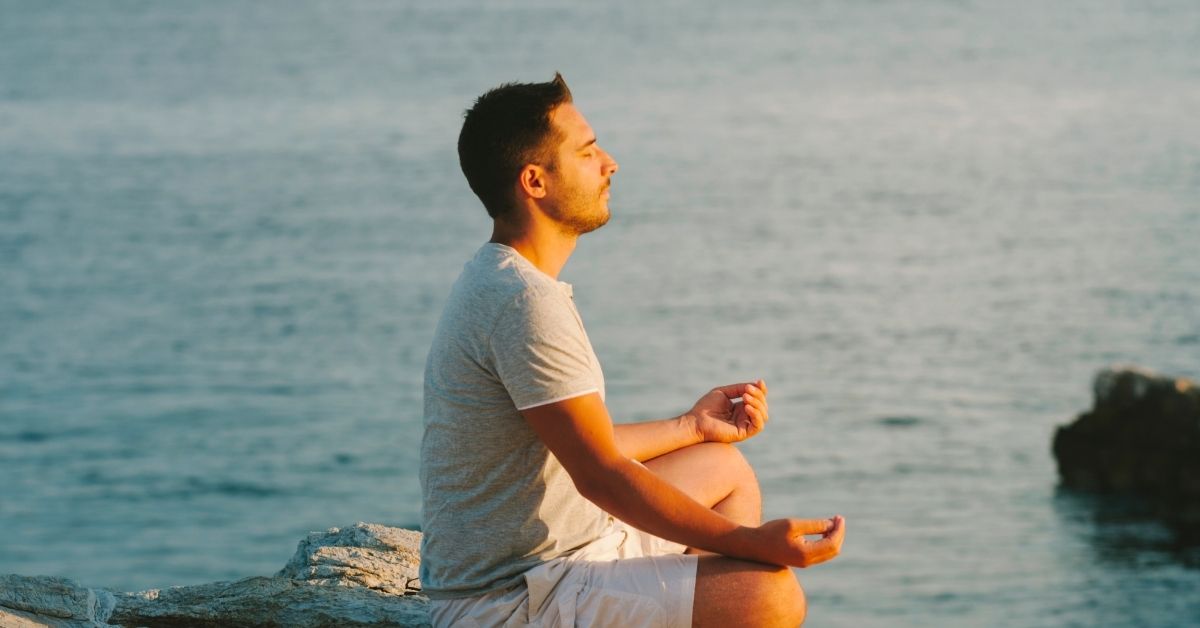Confession time. I don’t do well with sitting still and focusing my mind. While I don’t think I’m unique in these attributes, they make meditation a challenge. So when I was tasked with testing meditation apps, I wasn’t sure how successful I’d be at picking it up as a personal practice. Nonetheless, with our top pick Headspace, available for Apple and Android, I grew to enjoy the practice and even look forward to the daily content.
If Headspace can convert someone as skeptical as I was, I’m convinced others looking to explore meditation will enjoy its effective, beginner-friendly sessions, as well as its other offerings, from sleep-inducing bedtime stories to guided movement “workouts” that incorporate mindfulness in at-home strengthening and yoga poses. For people who struggle to get peace from a restless mind (or body), Headspace is a well-rounded meditation app with an abundance of diverse, high quality content.
What is headspace?
When you first download and open the headspace app, it launches you right into the mindset of meditation. The screen shows one of the app’s cartoon figures expanding and then shrinking, in conjunction with a reminder to breathe in and out. Then you’re prompted to create an account or sign in, after which you’re redirected to the home screen. There, you’ll find a daily meditation, as well as the “Wake Up,” a short sequence of videos that explain concepts or answer user questions, among other things. These videos usually start with a quick intro, followed by a short meditation—usually a minute, sometimes less—then circle back to the topic of the day. At first I thought I wouldn’t like or use the videos, but I came to thoroughly enjoy them. One of the best parts is users can skip over certain clips. I usually forgo the short meditation, especially if I am opening the app with the intent of meditating anyway
From the bottom of the main screen, users can navigate between tabs, labelled “Today,” which is the home screen, “Meditate,” “Sleep,” and “Move,” for quick access to specific content. The main page also has a search button in the upper right, allowing users to find meditations by keyword, such as “stress,” or “focus.”
The interface is user-friendly and intuitive. I never felt frustrated trying to find a topic or session, which is something all meditation apps should strive for, given their whole point is to help you relax.
How does headspace help you meditate?
headspace app boasts a broad and plentiful library of meditations users can choose from, ranging from work stress to anxiety, and even sessions geared towards coping with certain emotions, like loneliness and anger.
Many of the mediations are recorded separately by two voices, one male and one female. The male voice is that of the app’s co-founder, Andy Puddicombe. One of my favorite things about his style of meditation, and Headspace overall, is the acceptance and positive guidance he offers. The sessions don’t make users feel bad for getting distracted, which is almost inevitable for people just starting out. Puddicombe acknowledges it happens, and gives positive guidance and tips on how to manage a wandering mind. (These tips are emphasized in the “Basics” course that can be accessed in the free version, so you can decide if this aspect of Puddicombe’s style doesn’t speak to you before committing.)
Many of headspace free meditations come with a customizability unique to this app: the option to select the duration of a given session. While other meditation apps allow users to select sessions that are longer or shorter, Headspace gives users the ability to change the length of almost any session before they begin the actual meditation. So if you’re interested in the “Listening to Others Meditation” session, for example, but only have five minutes, you can select the duration that works for you, from three, five, or 10 minutes. Other meditations are as long as 20 minutes, but users can almost always choose a shorter time.
headspace app sessions didn’t make me nod off during daytime sessions, something that became a problem with other meditation apps I tried. Regardless of how I meditated—lying down, sitting, on the couch—my eyes only started sliding shut on one occasion. I found that the sessions hit the right amount of soothing without being so relaxing (or boring) that I fell asleep
The headspace app teaches eight meditation techniques, ranging from body scanning to focused attention to reflection. That said, I found comparatively few sessions for some techniques as opposed to others. I was only able to locate one definitive body scan, in which you start with your focus on a certain point in the body, most often the head or toes, and progress your attention up or down. What’s more, the maximum duration for that session was just three minutes. Body scans are incorporated into some nighttime wind downs, which I discovered as I tried more sessions; I just wish they were easier to find by searching the keywords “body scan” alone.
The vast majority of the meditations I tried, regardless of technique, were breath-focused. This type of meditation is good for many users, as breath is a universal experience and a controllable action that everyone can focus on. However, for some, such as people with anxiety that manifests as chest tightness, these meditations could make that sensation worse.
How can headspace help you sleep?
The sleep content on headspace is a nice perk, and provides enough variety for a casual user. It includes a handful of guided sessions that help you relax before you doze off, as well as Sleepcasts, which are audio tours of certain (often made-up) places.
Sleepcasts start with a “wind down,” such as a short visualization or breathing exercise to help users relax. Afterwards, listeners hear a detailed description of an imaginary location they tour with their mind’s eye, paired with white noise to match the setting. (For example, in “Rainday Antiques,” it sounds as if it’s raining outside the building.) Users are given a slider to adjust the balance of the ambiance to voice, which is a nice touch. However, you can’t change the voice on a given session, as with the meditations.
The sleepcasts provide more than enough time for most people to fall asleep, running for 45 to 55 minutes, well longer than the typical 10 to 20 minutes most take to doze off from when their head hits the pillow. The recordings are thoughtfully designed and slightly altered each time they are played, to vary the order of details. According to Headspace, this makes it easier for restless and anxious sleepers to doze off because they can’t memorize the exact narrative or track the passage of time by recalling when certain details or phrases emerge. The only downside, aside from lack of voice customization, is that users can’t skip forward or backward. So, you can’t just bypass the relaxation exercise, for example.
The app also offers about two weeks’ worth of night-specific guided exercises, including “wind downs” and “nighttime SOS” sessions. Wind downs prepare you for sleep by helping you relax and let go of the day. Unlike sleepcasts, which run as you doze off, these sessions are designed as bedtime prep. For people who like to sleep in silence, these come in shorter durations, anywhere from one to 20 minutes.
There are only five nighttime SOS sessions, which users can turn to when their sleep is interrupted by specific issues that might cause a sudden wake up, including work stress, nightmares, or pain. They are 10 minutes long and don’t offer users the option to adjust session length, not that you’d want to fuss with that after waking up bleary eyed from a bad dream.
Users can also choose certain sounds to help them fall asleep, called “sleep music,” or “sleep radio,” though the latter isn’t really what you’d think. Sleep radio refers to extended, as in 500-minute recordings (or over eight hours!) of one of three categories of sound: rain, ocean, or music.
The sleep section on Headspace isn’t where the app shines. Some of the selections are too small to be noteworthy, and the overall breadth of content is somewhat limited. But if you’re like me and just want a sleep story every now and again, it will serve you just fine.
How might Headspace improve your exercise routine?
In addition to the expected meditation content, Headspace has a Move section, which gives users access to several weeks’ worth of workout sessions, generally ranging in length from 10 to 30 minutes long, and from “mindful cardio,” to “rest day meditations.” One of the tenets of this content is the integration of mindfulness and breathing into exercise or general movement.
I tried one of the featured daily exercises, called “Reframing Anxiety,” a 20-minute workout that required limited equipment (an optional foam roller and yoga mat). While it was labelled as a workout, it wasn’t physically taxing. Rather than getting my heart rate up, the session emphasized breathing and focusing my awareness on the movements—mainly slow full-body stretches and strengthening yoga poses—I was making. During the session, I fell behind a couple of times, because I was unfamiliar with an exercise and needed to watch the on-screen guide. Fortunately, like the daily Wake Up videos, there’s an option to rewind and fast-forward, so I could just go back to figure out what to do.
The Move section is a nice plus that I’d use on occasion. That said, it wouldn’t be a sufficient reason for me to pay for full access.andy headspace
What does headspace cost?
headspace app has a free version, but the content is limited to just a handful of basic meditations and one guided session geared toward nighttime relaxation. On the free version, users can try out the 10-session Basics course, which provides a good taste of the style and tempo of Headspace meditations. Given these limitations, those looking to build a habit and meditate daily will need more than the free version can offer, making the paid option a better bet. headspace offers a free two-week trial of the premium version, to let you dig in a bit more before you buy.
headspace recently lowered its annual fee to $69.99, from nearly $100. That breaks down to $6 a month (which is less than a basic Netflix subscription)—and puts its cost right in the mid-range of the meditation apps we tested. The developers provide free access to certain groups, including K-12 educators. Headspace is also currently giving full free access to healthcare professionals, and people who are unemployed, in response to the coronavirus outbreak.
Why you should try headspace
headspace meditation offers a great array of features, from quality meditations to daily videos, as well as sleep and exercise-specific content. The app is well-rounded, and while it could stretch itself too thin for certain users or for specific headspace meditation techniques, the content all meets a level of polish and quality. I’ve yet to be disappointed by a Headspace meditation session or sleepcast. And while the sleep and movement content wouldn’t be enough for me to download the app, I consider them a worthwhile bonus.
headspace meditation excels in its intended use: headspace meditation . I found myself wanting to use it beyond the testing I did for my job here at Reviewed, and for someone who was skeptical of the practice, that says something.




